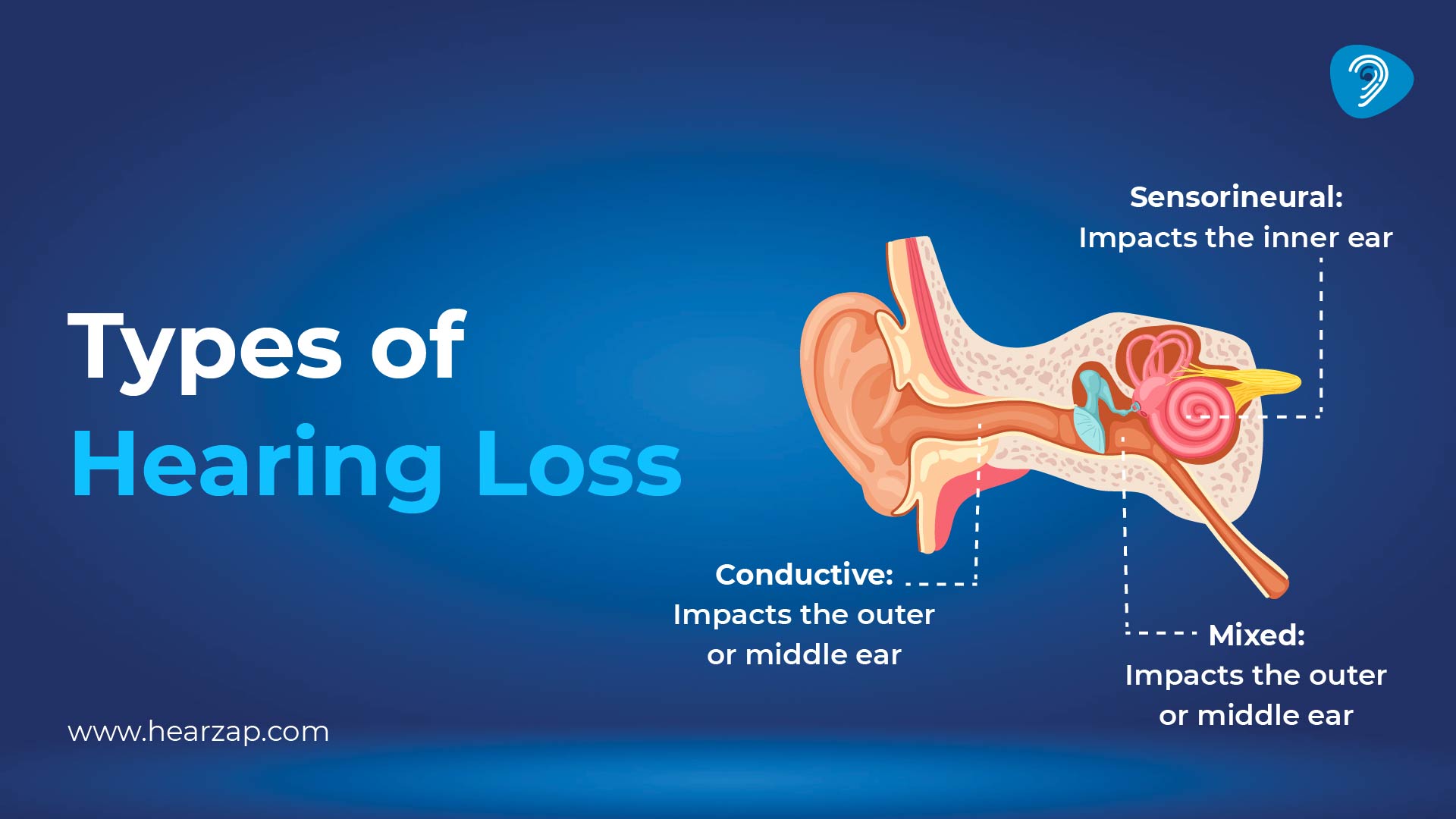HEARING LOSS
Understanding Types of Hearing Loss
By Team Hearzap | Oct. 1, 2025

Losing the clarity of everyday sounds rarely happens overnight. For many people in India, it appears gradually missing doorbells in a busy apartment block, turning the TV up during the cricket, or finding conversations harder to follow in a crowded metro or at a family function.
Because hearing works through a delicate chain the outer ear collecting sound, the middle ear transferring it, and the inner ear translating it to signals for the brain - difficulties can arise at any link.
This guide explains the main categories of hearing difficulty, how they are assessed, and practical steps that can make communication easier at home, work, and school. When you understand where the challenge sits, you can ask better questions, set expectations, and choose strategies that fit your routine.
You will also find a quick types of hearing loss chart summarising the three categories, the common hearing loss symptoms, and the usual causes of hearing loss.
What is Hearing Loss?
Hearing loss simply means your ears are not picking up sound as easily as before. It can be mild (soft sounds are harder to notice) or profound (even loud speech is difficult). Some people struggle more with higher pitches like children’s voices or birds. Others find lower tones tricky. You might also hear sounds but find words unclear, especially in noisy places like traffic, markets, weddings, or festivals.
An easy way to picture it is that something in the hearing pathway is not working at its best. That might be:
- Sound not travelling well through the outer or middle ear.
- The inner ear not turning sound into signals clearly.
- The brain not receiving or making sense of those signals.
To check your hearing, an audiologist uses a simple test with beeps called pure-tone audiometry. The result is an audiogram, a chart that shows how loud sounds need to be at different pitches for you to hear them. Based on this, hearing is usually described as mild, moderate, severe, or profound. Hearing difficulties can affect one ear or both, and they can appear suddenly or build up slowly over time.
Children and adults can experience hearing loss differently. A child with a mild change may miss parts of classroom instructions and fall behind without anyone noticing. An adult may feel tired after meetings, or find that conversations in busy places are especially draining.
Remember, it is not only about volume. Two voices at the same loudness can sound very different to someone with inner-ear changes. One voice may feel crisp, while another seems fuzzy. That is why many people say, “I can hear you, but I cannot understand you.”
If any of this sounds familiar, a quick hearing check and a chat with an audiologist can make the next steps clear.
A quick everyday frame of reference:
Normal conversation usually sits around 60 dB. A person with a mild loss might hear voices when the room is quiet, but struggle the moment a fan or traffic noise is present. With moderate loss, even face-to-face chatting can feel unclear without additional volume or visual cues. Severe losses make most speech inaudible without support.
How is hearing tested?
Alongside the audiogram, clinicians may use speech recognition scores and tympanometry to check middle-ear movement. Testing builds a clear picture, clearly.
Different Types of Hearing Loss
Clinicians group hearing problems into three broad categories based on where the main difficulty sits. Understanding these categories helps you describe your experience and choose appropriate management.
Sensorineural Hearing Loss
Sensorineural hearing loss occurs when the inner ear’s sensory cells (hair cells) or the auditory nerve do not pass sound information to the brain effectively. It reduces clarity rather than just loudness, so people often say, “I can hear you, but I cannot understand you.”
Common Causes:
Ageing of the inner ear, long-term noise exposure (traffic, factories, loud music, firecrackers), certain medications known to affect the ear, head injury, and some infections. Family history can play a role too. In India, everyday noise from horns, construction, and festive speakers can add up over time, especially when ear protection is not used at work.
Typical Hearing Loss Symptoms
- Speech sounds muffled, especially consonants like s, shh, th, and f
- Difficulty following conversations in restaurants, offices, or trains.
- Needing subtitles or higher TV volume than others in the house.
- Tinnitus (ringing or buzzing) may accompany it.
- Feeling more fatigued after social events because of listening effort.
How it is Usually Assessed
An audiologist or ENT specialist uses pure-tone audiometry, speech tests, and sometimes tympanometry or otoacoustic emissions. The pattern often shows reduced hearing at higher frequencies.
Management options: While damaged inner-ear cells do not regenerate, many people benefit from modern hearing aids tuned to their hearing profile. Today’s devices can reduce background noise and emphasise speech. Communication tactics (face the speaker, good lighting for lip cues, and choosing quieter seating) also help. In advanced cases, cochlear implants or bone-anchored solutions may be discussed by the clinical team.
Safe-listening habits: Limiting time near loud speakers during festivals, using earplugs at factories or construction sites, and keeping personal earphones at a moderate level protect the inner ear. Follow the simple rule: if you cannot hear someone at arm’s length without raising your voice, the sound may be too loud for extended exposure.
Conductive Hearing Loss
Conductive hearing loss arises when sound cannot efficiently pass through the outer or middle ear. Think of it like a door that does not open fully; the room (inner ear) might be fine, but less sound gets through.
Typical Causes to be Aware of:
Earwax build-up, ear infections, fluid in the middle ear after a cold or sinus problem, perforated eardrum, issues with the tiny ear bones, or problems in the ear canal (for example, a trapped foreign body in a child’s ear). Otosclerosis, a condition that stiffens the stapes bone, is another example. Swimming with existing ear problems can sometimes worsen blockage.
Characteristic Hearing Loss Symptoms
- Sounds seem softer or blocked, like wearing earplugs.
- Your own voice may boom or echo (occlusion effect).
- Ear pain, pressure, or a feeling of fullness during colds.
- Sudden drop after a swim because water is trapped against wax.
- Often better clarity once volume is sufficient.
Assessment: Examination with an otoscope checks the ear canal and eardrum. Tympanometry measures middle-ear pressure and mobility. Audiometry looks for an air-bone gap, which is a hallmark of conductive patterns.
Treatment avenues: This type often improves with medical care. Options include professional wax removal, ear drops, decongestants or antibiotics where appropriate, and minor procedures such as grommet insertion to drain fluid.
Prevention pointers: Keep ears dry during infections, avoid inserting objects into the canal, and seek advice if you notice recurring blockage after colds or allergy seasons. For children, regular check-ups after repeated ear infections help catch fluid build-up early.
Mixed Hearing Loss
Mixed hearing loss is a combination of inner-ear (sensorineural) changes and a conductive component. A person might have longstanding inner-ear changes from noise or age, plus a new middle-ear issue like fluid or wax.
Both clarity and loudness are affected. Raising the volume helps a bit, but speech can still feel blurred, particularly in noisy places. On some days, it feels better than others if the conductive element fluctuates.
Likely Hearing Loss Symptoms
- Difficulty with soft voices and children’s speech.
- Trouble on the phone and in group meetings.
- A feeling of blocked ears alongside overall reduced clarity.
- Tinnitus may or may not be present.
Management
Our care usually addresses both sides of the problem: medical treatment for the conductive element (for example, wax removal or infection care), along with hearing aids or other amplification for the inner-ear component. A tailored plan from our audiologist and ENT team is key to proper healing.
Daily-life Tips
Track patterns in a small diary - when it feels better or worse, and what was happening that day. This helps clinicians fine-tune treatment and settings.
Causes of Hearing Loss
- Genetics
- Infections
- Trauma
- Loud noise
- Ageing
When to See a Doctor?
Knowing when to book an appointment can save months or years of unnecessary strain. Consider a check-up if you notice any of the following warning signs:
- You ask people to repeat themselves often, especially in cafés, offices, or crowded family gatherings.
- Friends comment that your TV or phone volume is high compared with theirs.
- You hear but struggle to understand speech, particularly consonants, or you mix up similar-sounding words.
- You avoid group conversations because they feel exhausting.
- You experience tinnitus, ear pain, repeated ear infections, or a feeling of blocked ears.
- You had a recent head injury, severe cold, or exposure to very loud noise.
- A child in the family turns the head to one side when listening or does not respond to soft sounds.
Early diagnosis matters because it keeps communication easier at home, school, and work. Timely support also helps reduce listening fatigue. An audiologist can carry out hearing tests and explain results in simple terms. If needed, they may refer you to an ENT specialist.
- You notice one ear is much worse than the other, or a sudden change in one ear.
- Ringing or fullness appears after a loud event and does not settle after rest.
Conclusion
Understanding the main categories - sensorineural hearing loss, conductive hearing loss, and mixed hearing loss - gives you a clear map of what might be happening and what to ask at your appointment. Each type relates to a different part of the hearing pathway, so the assessment focuses on finding which link needs support. The quick types of hearing loss chart above is a useful refresher before you speak to a professional.
You recognise several of the hearing loss symptoms described here, consider booking a hearing check. Many people find that small, practical changes—such as better seating in noisy settings, consistent ear care, and well-fitted hearing devices when appropriate—make daily conversations less tiring. If you look after children or older relatives, encourage routine ear and hearing reviews, just as you would for eyes or teeth. When in doubt, arrange an appointment with a qualified audiologist or ENT specialist for clear, personalised guidance. You can conveniently book a hearing test or consult an audiologist through Hearzap, ensuring expert care and support for your hearing health.
FAQs
What is the classification of hearing loss?
Clinically, classification follows where the difficulty arises: sensorineural hearing loss (inner ear or nerve), conductive hearing loss (outer or middle ear), and mixed hearing loss (a combination). Severity is described from mild to profound using audiometric thresholds.
What is mixed conductive and sensorineural hearing loss?
It means there are two components at once: a conductive element (for example, wax or middle-ear fluid) and an inner-ear element that affects clarity. Managing both together - medical care plus amplification, usually brings the best result.
What are the 3 levels of hearing loss?
A simple way to group them is mild (soft speech is missed), moderate (normal conversation is difficult without support), and severe-to-profound (even loud speech is hard). Exact cut-offs come from the audiogram.
How to tell if hearing loss is sensorineural or conductive?
Testing helps. An ear examination, tympanometry, and an audiogram show patterns: conductive loss typically has an air-bone gap; sensorineural hearing loss shows reduced inner-ear sensitivity without that gap.
What type of hearing loss cannot be fixed?
When inner-ear hair cells are permanently damaged, they do not regrow. While the underlying change is not reversed, people often improve communication with properly fitted hearing aids, assistive listening tools, captioning options, and practical strategies.
Related Blogs

Autoimmune Disorders and Hearing Loss: Is There a Connection?
Contact us
We are here for all your hearing needs, from hearing tests to hearing aids. Fill out the form below, and we will give you a call soon.
Please enter a valid mobile number with 10 digits.
Recent Blogs
By None | Dec. 4, 2025
By None | Dec. 2, 2025
By None | Nov. 28, 2025
By None | Nov. 27, 2025
By None | Nov. 26, 2025









